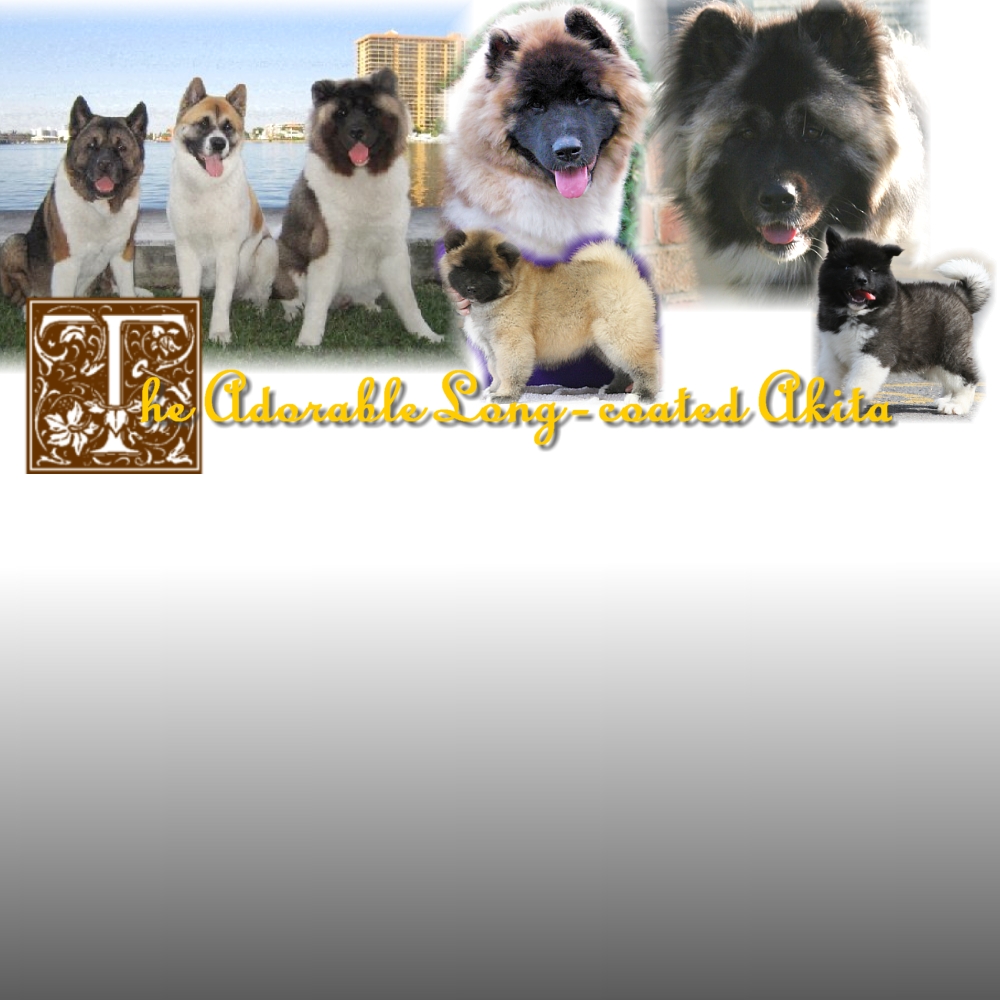
Many purebred breeds of dogs have different coat varieties; Chows come in rough and smooth as do Collies and St. Bernards and there are several others as well. Some breeds have even more varieties such as the Dachshund, which comes in long, short and wire coats. There are also many breeds that, while they have different coat varieties, can’t be shown in those varieties. They are either seriously penalized or disqualified in their breed’s standard. The long coated variety in Akitas is considered a fault and is not a disqualification. The standard includes several other characteristics that are considered faults as well including narrow or snipy heads, loose shoulders and elbows in or out while moving. Light bone and rangy bodies are actually considered serious faults. But of all the faults and disqualifications in our breed, only the long coated Akita is considered such a stigma that it is almost never seen in the conformation ring. In fact, the long coated Akita has been seen in public so little up until very recently that most people aren’t aware that they exist.
The gene for long coat is a simple recessive one. At this point, most breeding programs carry the long coated gene and will produce the occasional coated puppy. Like their short-coated brethren, the long coat has many variations of actual length and texture from very slight feathering on what basically looks like a short coat to a coat so huge and wooly it nearly reaches their feet. Just like short coats, long coats can come in any colour and they exhibit all the normal breed characteristics. So in all respects other than coat length, the long coated Akita is just like the short coated Akita. Some breeders feel that the long coats do seem to have a higher than average number of dogs with large size, heavier bone and larger heads and that this overall greater size isn’t merely attributed to the visual perception of largeness from the fuller coat but that they are actually bigger dogs. Most breeders agree that long coats are typically more tractable, friendly and gentle in temperament. I don’t think anyone denies the huge “cute” factor. Since they are merely considered a simple fault per the breed standard they can be shown. But at this time, unless provisions are made that make it clear that long coated Akitas are allowed in the show ring, the majority of judges would consider a long coat a blatant fault. Whether a breeder decides to include a long coat in their breeding program or not is solely personal choice. There is nothing in this country forbidding it and some breeders feel that their best coat quality comes through long coats or long coat carriers. Managed well it can be an asset and might possibly be the source of a broader gene pool.
While the one very distinct and irrefutable difference between the short and the long coated Akita is that the hair is indeed longer than the standard’s ideal for the show ring, that is basically the only difference in the coat as both varieties come in a widely varying range of density and texture. The long coat with a softer, silkier guard coat will feel softer than the short coat merely because of length and the long coat with a bigger softer under coat will appear bigger and fuller than the short coated variety again merely because of the additional length. There isn’t “more” hair on the long coat, only longer hair. The long coated Akita sheds exactly like the short coated Akita and they blow (molt) their coat once or twice a year with little shedding in-between the coat blows. Caring for the long coated Akita is not that much different than a short coated Akita. Both coat types need a good weekly grooming to maintain condition and manageability. The long coat should be groomed with a long toothed pin brush and a very long toothed metal comb (such as Chris Christiansen’s Butter Comb #005 or #009 http://www.chrissystems.com/grooming-tools/pet-grooming-show-dog-and-cat-combs.aspx rather than a bristle brush. The coat should be pin brushed starting from the outer coat and working inward until it’s easily separated and then combed to the skin until the comb slides through the coat freely. Special attention should be paid to behind the ears, the armpits and inside the rear legs where the coat is often softer and silkier and tends to knot easier. Never drag the pin brush or comb through a tangled coat but rather work the coat slowly from the outer tips to the skin. If this is done once a week or even more often, it’s a very short process from start to finish. End with a nice pedicure and your Akita will look lovely year around. I have found that the easiest way to manage either a long coat or short coat through the heavy shedding period is to give several baths with a good force air, blow drying to get out the worst of the undercoat. If you do not have the time or inclination to groom your Akita, regardless of the coat length then regular trips to the groomer are a must. All dogs need regular grooming including nail trims, ear and teeth cleaning and a good brush and/or comb out but the double coated breeds require extra attention to keep the coat from matting and the skin healthy.
Because the long coated Akita is such a magnificent dog with that amazing coat, the natural breed presence and their famous ultra sweet temperament, they are just total people magnets. Everyone wants to pet them, hug them, touch the coat, and kiss them making it even more important that they get the proper training and socialization. Children love to pet their feet, something not all Akitas are fond of, and so a lot of handling is very important from the time they are baby puppies just like it is with any Akita regardless of hair length, sex, or pedigree. Their whole aspect makes them look warm and cuddly and inviting but no matter how casual their nature, how touchable their coat, how inviting their friendly smile is, they are still all Akita and they should be trained and handled as such. Never make the mistake of thinking a long coated Akita is like a Golden Retriever.
We are the proud breeders of many long coated Akitas with amazing temperaments and accomplishments. From cancer detecting to therapy dogs, they are an amazing and talented group with equally amazing and talented owners who have allowed them to excel and shine in so many different areas and most importantly, they are all adored family members.
Many, many more gorgeous longcoated Akitas are featured at the following link: http://pets.webshots.com/album/582632469dWntay?start=12
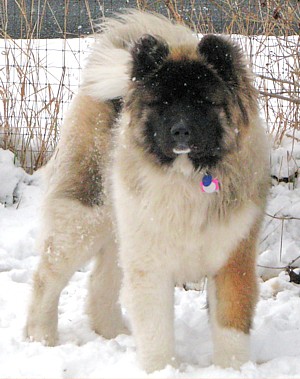
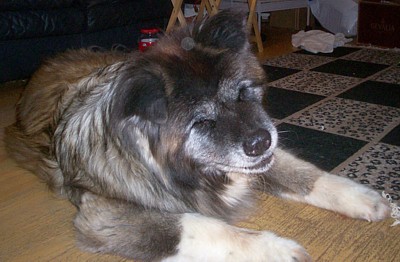
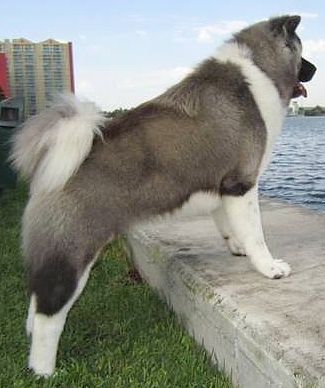
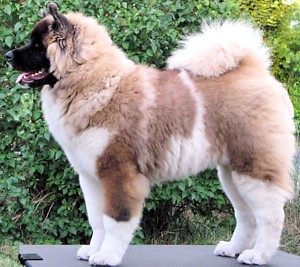
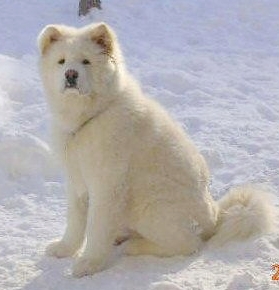
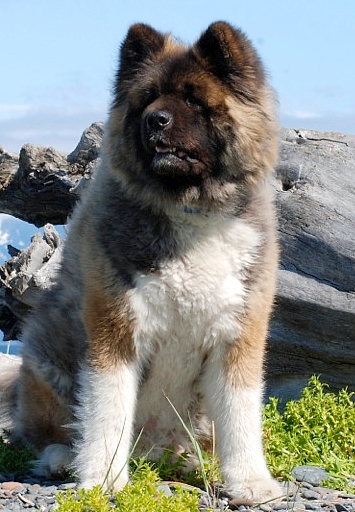
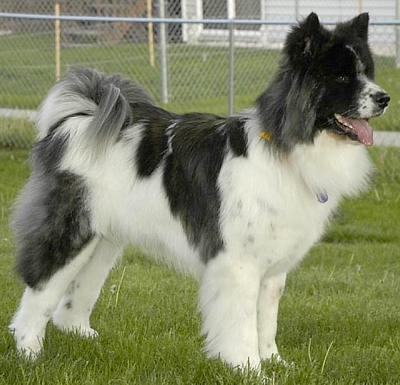
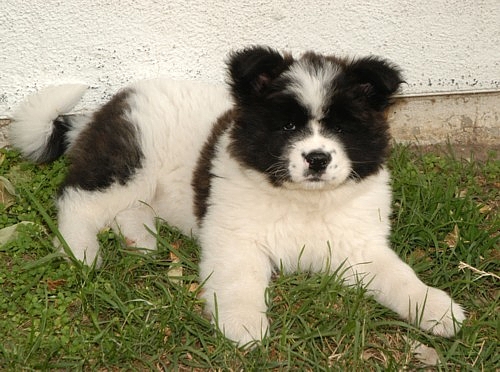
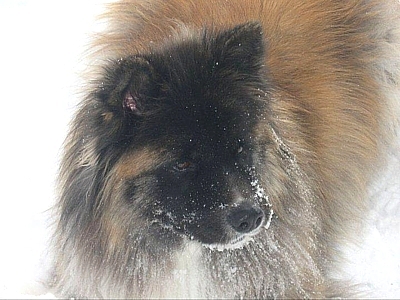
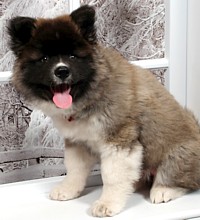
Magnificent longcoated Akita, Joy, in the snow. Photo courtesy of Priscilla Sharpe
This gorgeous longcoated Akita enjoys living in the mountains, photo courtesy of Mystik Akitas
White longcoated Akita in the snow, photo courtesy of Mystik Akitas
Brindle pinto longcoated Akita, Brisa, as a puppy and as an adult, photos courtesy of Gekko Akitas
Joy on the grooming table, photo courtesy of Priscilla Sharpe
Mikey at the lake, photo courtesy of Annette Amsel.
Longcoated Akita puppy, Two Black at 7 weeks
Longcoated Akita, Jerzee, as a puppy and as an adult, photos courtesy of Gekko Akitas
A senior citizen longcoat, Titan at 12 years, photo courtesy of Gekko Akitas

